FOR IMMEDIATE RELEASE
ACS News Service Weekly PressPac: June 08, 2016
DNA scrunching could be new target for antiviral drugs
"DNA Scrunching in the Packaging of Viral Genomes"
The Journal of Physical Chemistry B
Vaccines have saved countless lives since their first use more than 200 years ago. But treatments for infections once they take hold can be hard to come by. Now scientists could be onto a new approach to developing antiviral therapies. In ACS’ The Journal of Physical Chemistry B, scientists report that DNA may “scrunch” like a worm to get inside viral shells. This deeper understanding could help lead to novel ways to fight pathogens.
A critical step in viral replication is its packaging. Viral particles invade host cells, then hijack their machinery to make copies of viral genetic material and build protein shells called capsids to house the DNA or RNA. Scientists have been studying how the genetic material is driven into capsids so they might one day block this step. The proteins driving this process are among the strongest biological “motors” known. Most scientists have assumed that these proteins act like levers to push DNA into capsids. But Stephen C. Harvey and colleagues wanted to investigate whether DNA itself actively scrunches its way in by shrinking and then elongating like a worm.
To test their hypothesis, the researchers simulated interactions between a protein and DNA sequences from a virus. The computer models suggested that the DNA scrunched up spontaneously without any lever-like protein motions. If further testing bears out this proposed mechanism, it would demonstrate for the first time that DNA shape changes can produce strong forces. These modeling studies were carried out on a non-pathogenic virus, but the same packaging mechanism is used by herpes viruses, Harvey says. These pathogens cause diseases such as chicken pox, shingles, infectious mononucleosis, and oral and genital lesions.
The authors acknowledge funding from the National Institutes of Health and the National Science Foundation.
High-resolution image


